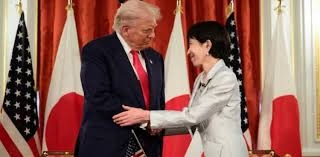Japan and the United States have reached a major agreement to collaborate on next-generation nuclear power reactors and rare earths supply chains, marking a significant step in reducing China’s control over critical minerals vital for electronics, defence, and clean energy technologies.
U.S. President Donald Trump and Japan’s new Prime Minister Sanae Takaichi signed the framework agreement on Tuesday at the ornate Akasaka Palace in Tokyo, underlining their commitment to strengthening cooperation in energy security, technology exports, and supply chain resilience. The pact includes provisions on critical minerals, with both leaders pledging to secure and diversify supplies of rare earths used in industries ranging from automobiles to fighter jets.
While neither leader directly mentioned China, both nations share concerns over Beijing’s dominance, as China currently processes over 90% of the world’s rare earths and has recently expanded export restrictions.
The White House said the two countries would use economic policy tools and coordinated investments to foster “diversified, liquid, and fair markets” for rare earths and other critical minerals, with financial support for projects expected within six months. The agreement also proposes a joint stockpiling mechanism and deeper cooperation with international partners to ensure supply chain security.
According to Eurasia Group, China remains the top player in rare earth extraction, while the U.S. and Myanmar control 12% and 8% of global output, respectively. Malaysia and Vietnam together account for another 5% in processing, where China also dominates.
Nuclear Energy Cooperation
Japan and the U.S. also agreed to collaborate on building AP1000 advanced reactors and small modular reactors (SMRs) — technologies expected to play a central role in next-generation nuclear power. Japanese companies such as Mitsubishi Heavy Industries and Toshiba Group are likely to participate in these projects.
Prime Minister Takaichi, Japan’s first female leader, has made nuclear power revival a key priority, emphasizing its role in achieving energy security, affordable electricity, and technological exports. Japan’s nuclear sector has remained largely dormant since the 2011 Fukushima disaster, while countries like China, Russia, South Korea, and France have taken the lead in exporting nuclear technology.
A separate White House statement noted potential cooperation in fusion energy, another area strongly supported by Takaichi. Around 20 U.S. and Japanese companies have already expressed interest in investment projects linked to a $550 billion economic package unveiled during the talks.
LNG and Energy Diversification
The discussions also touched on energy diversification. Before Trump’s Asia visit, Washington urged countries — including Japan — to reduce reliance on Russian energy, tightening sanctions on Moscow’s key oil exporters Rosneft and Lukoil.
Japan, meanwhile, has been increasing U.S. LNG imports to compensate for potential disruptions from Russia’s Sakhalin-2 project, which currently provides 9% of Japan’s gas needs. The bulk of Sakhalin-2 contracts will expire between 2028 and 2033.
In June, Japan’s largest LNG buyer JERA signed a deal to import up to 5.5 million metric tons of U.S. LNG annually under 20-year contracts beginning around 2030 — nearly matching volumes from Sakhalin-2.
Despite U.S. pressure, Japanese officials have indicated they may continue limited imports from Russia, citing lower costs and shorter delivery times compared to U.S. and Alaskan shipments.
Energy expert Nobuo Tanaka, CEO of Tanaka Global Inc., summarized the dilemma:
“The U.S. wants Japan to stop importing Russian energy — but Sakhalin LNG is cheap and nearby. The real question is whether American gas can be as affordable.”
The new U.S.-Japan pact thus represents a strategic attempt to balance energy security with geopolitical alliances, while reviving Japan’s nuclear ambitions and reducing dependency on China’s mineral supply chains.



